LatexWorkShops  always happy to help
always happy to help
Buying Outfits
The Internet is great for getting an idea of prices, and indeed the variety of styles available. However, the best plan is to the shops for quality assurance, and valuable advice from the staff. You should even be able to try it on, useful for sizing, style and choosing colours that suit you. If you would like to know anything more, you are always welcome to contact us. Naturally, you can always learn how to make your own individual bespoke outfit at one of our Workshops.
What to look for…
Make sure you are pleased with the design and fit; that the seams are positioned for a good fit, so can you look fabulous. One very important detail, always check the finishing. If the finishing is good, that is for example, it has proper stress point guards. This shows that extra care and understanding has been applied and so the garment is much more likely to last longer and look better when worn. Quality outfits usually come with a reasonable guarantee, so make sure you ask for one.
Stress Points
Seams. In the 1st Picture, the seam is very thin, only about 0.5cm. it should be 1cm. It has been joined together without a stress point guard at the end of the seam. As you can especially see from 2nd Picture this makes the seam weak and susceptible to ‘peeling‘.
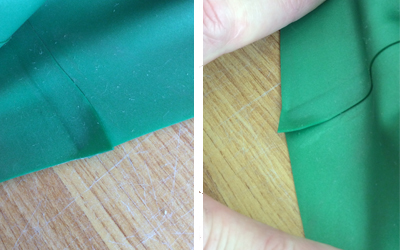
Zips. In the 1st Picture there was no original stress point guard at the bottom of the zip : the stopper end . A thoughtful person did add a stress point guard bottom section but did not make it quite deep enough ; it should be 2.5cm in depth, from the stopper. As this is a stressful area it must be protected. In total a stress point guard needs to be added to either side of the zip and the bottom end of the zip. In the 2nd Picture, the zip does not even have a stress point guard. Not unsurprisingly, the stressed end tore very easily.
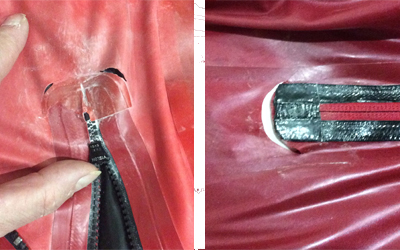
Poor Finishing
Inconsistent seams ; stretching, picture below, giving the seam a ‘gathered’ look, lumps, bumps, kinks, air bubbles and so on. You will know if the finishing is of a low standard and what needs to be done.
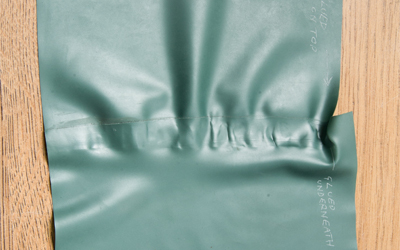
Eyelets and studs should be reinforced, with cotton tape. We were asked to repair some eyelets of a very expensive brand, as they had broken free. They had used cotton tape but the holes had been made too close to the edge and had simply given way under the slightest of stress. You will notice that the eyelets are irregular and often far too close to the edge. Repairing this outfit was not financially viable. We recommended the customer ask for their money back.
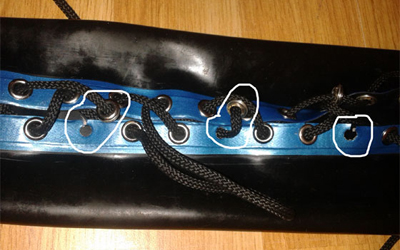
Good Finishing
Consistent seams 1cm in width. Stress point guards where required ; at the end of all seams, under armscye, under crutch depth line, any other stress points, e.g., plunge neck line, around zips and any where for feel that there will be accuse stress. If the garment has eyelets or studs ensure they are reinforced, with cotton tape and the holes are regular and a sufficient distance from the edge. The 1st Picture is a perfect stress point guard as it is in the middle of the stress not the middle of the seam. The 2nd Picture is how a zip should look ; stress point guard all around the zip.
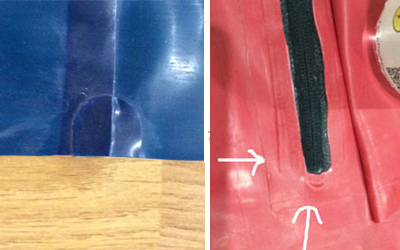
Latex Care
Before Wearing
Your outfit should be either new or have come out of storage. Either way it should be in perfect condition. However, if you would like to make sure you can give your outfit a wipe down with Perv-O-Shine to clean it ; using a lint free cloth. The picture below is my outfit being unwrapped from tissue paper, taken from it’s exclusive draw.
I would recommend having a shower before wearing latex, as it will help you get smoothly into your outfit. It also has the advantage of removing any perfumes which may well stain your outfit. Also, it makes the latex feel nicer against your clean skin.
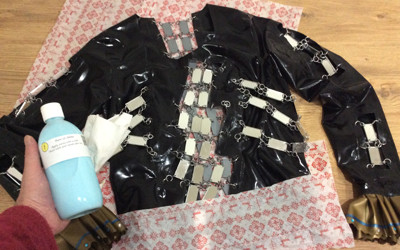
Wearing – getting into your outfits
Personally, I rarely use zips or studs and so I must slide into my outfit. To do this I prefer to wipe a little silicone on my body where my outfit may have trouble gliding on, e.g., on the bottom half of my shoulder blades. Generally, your bust and hips. Then I just slide into my outfit. If you are wearing a small outfit, like shorts or knickers, it’s easy just to pull them on. I prefer not use talcum powder when dressing. The clouds of talcum powder make it a messy process and by the end of the evening perspiration causes any remaining talc to cake like lumps of plaster. It is recommended not to use baby oil, as it eventually has a detrimental effect on your latex.
Apart from stainless steel avoid contact with metals, e.g., brass, copper, (necklaces, rings) even some coins. Of course take care with pointed jewellery, watches, studs, long fingernails, as they may damage your outfit. When dressed and at your destination apply a liberal amount of silicone (Vivishine, Eros, Pjur Cult) for that lovely glossy look using some lint free cloth, or preferably a warm pair of hands.
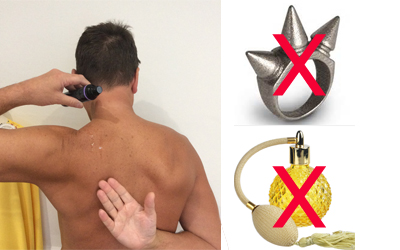
After Care
Once you have taken off your lovely outfit,it is better to clean it at your earliest convenience, leaving it too long may be detrimental. I have found cleaning with Perv-O-Shine to have the best result. Personally, I prefer not to wash with tepid soapy water, as I find it has a detrimental effect with any zip and I get a better result with Perv-O-Shine. However, washing is done in tepid soapy water and then rinses in tepid clean water. Then either dry with lint free cloth or if warm enough allow it to dry naturally, but do not dry it in the sun.
Once dry, I wipe my latex with silicone based lube, this prevents any drying of the latex and those white rings that look like salt. Now I fold or hang in sealed bags/containers and store in a dark place, at average temperature, just not extreme.
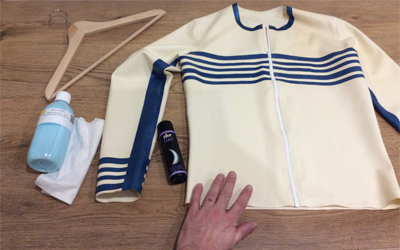
Storage
Store each outfit individually. Picture 1 shows a skirt being gently rolled / folded in tissue paper, always taking care with any sharp accessories, like buckles, studs. Then place in a drawer, or you can place it on a shelve, avoiding light, at a constant normal room temperature, so avoiding radiators / heaters, also not too cold. You may choose to hang your outfit, as in Picture 2, you may have a dedicated latex wardrobe, even better maybe in an overcoat bag but make sure your outfit won’t stretch, that is, tops and most dresses should be fine but catsuits may well be a little too heavy. Also, make sure nothing will make a stain and so make sure your hanger is plastic or wooden, careful of splinters but be careful of any metal, eg, the hanger hook, other zips (from the overcoat bag) or any other part of the wardrobe.
Then when you take it out for your next adventure it will be perfect.
